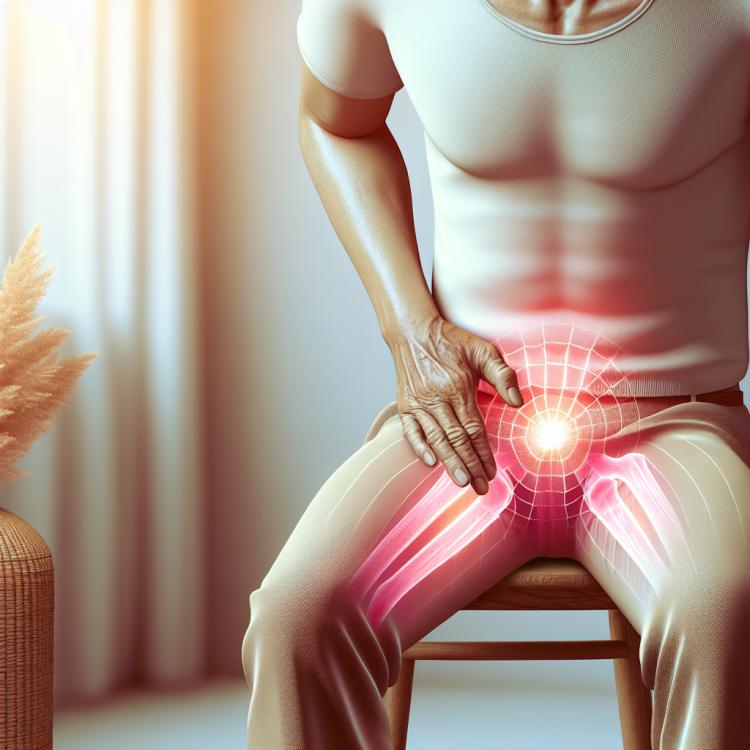
Causes and treatment of hip pain: advice and diagnosis
About the Symptom
Pain in the thigh is a symptom that can arise for various reasons and significantly affect the quality of life of the patient. It can manifest as acute or chronic discomfort and encompass both the front and back of the thigh. It is important to note that the localization and nature of the pain can vary depending on the underlying cause related to the condition of the joints, muscles, or nerves. For example, osteoarthritis, injuries, or inflammatory diseases can cause specific discomfort in this key joint, limiting mobility and the ability to perform daily activities.
This pain can be associated with an injury sustained from both active sports and everyday incidents. However, aside from mechanical injuries, there are other serious causes such as thrombosis, infectious diseases, or tumors that can trigger pain in the thigh area. Therefore, it is crucial to correctly assess the nature of the pain, its duration, and accompanying symptoms to promptly consult a specialist for diagnosis and adequate treatment.
Diseases
Pain in the hip can be a symptom of various diseases and conditions that require a careful diagnostic approach. One of the most common diseases causing this discomfort is osteoarthritis, which leads to the gradual destruction of the cartilage covering the joint and provokes inflammation. This condition can occur in both older people and those who are actively engaged in sports, which increases the load on the joints.
Another common disease is bursitis, in which the sac containing fluid (bursa) that serves to reduce friction between bones and soft tissues becomes inflamed. Bursitis can be a result of excessive physical strain, injuries, or chronic inflammatory processes. It is also worth noting diseases such as tendinitis, osteonecrosis, and sciatica, which can lead to hip pain depending on the location and extent of tissue damage.
- Osteoarthritis
- Bursitis
- Tendinitis
- Osteonecrosis
- Sciatica
- Fractures
- Fibromyalgia syndrome
- Piriformis syndrome
- Discogenic pain
Diagnosis
Proper diagnosis is a key stage in determining the causes of hip pain. Doctors use a variety of methods and tools for diagnosis that help identify the underlying condition and exclude other possible states that could cause discomfort. Initially, the patient undergoes a medical examination during which the doctor collects the medical history and assesses the level of pain, its location, and duration. Evaluating the physical condition also allows the specialist to understand if there are any limitations in movement or sensitivity in the hip area.
Further investigations may include X-rays, magnetic resonance imaging (MRI), and computed tomography (CT). These imaging methods allow for a detailed examination of the structure of bones, joints, and soft tissues, which significantly facilitates diagnosis and the choice of further treatment. Additionally, laboratory tests may be prescribed to identify inflammatory processes and infections that may contribute to hip pain.
- Consultation with an orthopedist
- X-ray
- Magnetic resonance imaging (MRI)
- Computed tomography (CT)
- Ultrasound of the joints
- Blood tests (to identify infections and inflammations)
- Electromyography (EMG)
Which doctor to consult
When experiencing hip pain, it is crucial to consult a specialist for accurate diagnosis and appropriate treatment. Choosing the right doctor will help determine the causes of the pain and initiate the necessary therapeutic measures. Depending on the nature and intensity of the pain, as well as associated symptoms, you might start with a visit to a therapist who will assess your condition and refer you to a specialist if necessary.
The doctor may recommend consultations with various specialists, such as an orthopedist, traumatologist, or rheumatologist, depending on the suspected cause of the pain. Additionally, if neurological issues are the cause of the pain, it is advisable to see a neurologist. An individualized examination and treatment program will help restore your comfort and return you to an active lifestyle.
- Therapist
- Orthopedist
- Traumatologist
- Rheumatologist
- Neurologist
- Physiotherapist
Types of Hip Pain
Hip pain can manifest in various forms, each of which may be associated with certain diseases or conditions. It can be dull, sharp, pulsating, or burning. Dull pain often arises from overloads or injuries, while sharp pain may indicate more serious issues, such as dislocation or fracture. Pulsating and burning pain may suggest inflammation or nerve compression.
Additionally, hip pain can vary in duration: it can be chronic if it lasts for several weeks or months, or acute if it appears suddenly. The conditions under which the pain occurs also matter — it may worsen with movement, or it may be present even at rest. Understanding the types of hip pain will help you better describe your symptoms to a doctor and receive appropriate treatment.
- Dull pain
- Sharp pain
- Pulsating pain
- Burning pain
- Chronic pain
- Acute pain due to injury
Causes of Hip Pain
Hip pain can be a manifestation of many different diseases and conditions affecting this area of the body. It can range from mild discomfort to sharp intensity, making it an important symptom for diagnosis. One of the main causes of hip pain is joint problems, such as osteoarthritis or bursitis, which can cause inflammation and restrict mobility. Pain can also result from injuries, such as dislocations or fractures.
Additionally, some systemic diseases, such as infectious processes or circulatory disorders, may also lead to hip pain. This can result from thrombosis in the veins or arthritis, particularly rickets. More rare, but no less important causes include tumors or metastases in the hip area, which require careful diagnosis and treatment. Understanding the underlying factor causing the pain can significantly aid in choosing the right treatment methods.
- Osteoarthritis
- Tendinitis
- Bursitis
- Injuries (dislocations, fractures)
- Infections
- Thoracic outlet syndrome
- Radiculopathy
- Cancer or metastases
Common Related Pathologies
Pain in the hip may not only be an independent symptom but also a sign of accompanying diseases or pathologies. These conditions can significantly impact the overall health of the patient and require a comprehensive approach to diagnosis and treatment. Therefore, it is important to consider that hip pain is often associated with various diseases that either directly affect the joints and soft tissues or manifest systemic disorders.
Some of the common related pathologies include arthritis, bursitis, bruises, osteoarthritis, injuries, and inflammatory processes in the muscles and ligaments. These conditions can lead to a limitation of mobility and an increase in discomfort levels, significantly reducing the patient’s quality of life. Understanding these pathologies is essential for timely diagnosis and the selection of an effective treatment strategy to alleviate pain and restore hip functionality.
- Osteoarthritis
- Rheumatoid arthritis
- Bursitis
- Tendonitis
- Injuries and bruises
- Fractures
- Sciatica (inflammation of the sciatic nerve)
- Piriformis syndrome
Expert Opinion
Pain in the hip is a common problem that patients often ignore, assuming it is a result of fatigue or a sedentary lifestyle. However, it is important to remember that such pain can signal more serious pathologies, including injuries, inflammatory processes, and even degenerative changes in the joints. The reaction to pain and the desire to postpone a doctor’s visit can only worsen the situation, so it is essential to make an appointment with a specialist at the first signs.
According to orthopedic and rheumatology doctors, early diagnosis and appropriate treatment can prevent further progression of diseases and improve the patient’s quality of life. A large number of related conditions can have long-term consequences, including limited mobility and persistent pain. Generally, such conditions require a comprehensive approach that includes diagnosis, physiotherapy, and, in some cases, surgical intervention.

Treatment of Hip Pain
The treatment of hip pain depends on the cause of the symptom. It is important to establish an accurate diagnosis, as different conditions require an individualized approach and treatment. Initially, the doctor may recommend conservative measures such as taking anti-inflammatory medications, applying ice packs, or physiotherapy to help reduce inflammation and relieve pain.
In cases where conservative treatment does not yield the desired results or if serious pathologies are discovered, surgical intervention may be necessary. Surgery may involve repairing damaged tissues or joint replacement, which is particularly relevant in degenerative diseases. It is also important to pay attention to rehabilitation after treatment, which plays a key role in returning to a normal life.
- Physiotherapy
- Massage
- Medications (non-steroidal anti-inflammatory drugs)
- Corticosteroid injections
- Surgical intervention (if necessary)
- Exercises to strengthen muscles
Complications
Pain in the hip can be a symptom of various diseases, and ignoring this ailment can lead to serious complications. If medical help is not sought in time, the pain can progress, creating additional problems not only in the joint area but also in the functionality of the limbs. For example, chronic pain can lead to changes in gait, which, in turn, can place stress on other joints, such as the knees and spine.
One of the main complications is limited mobility, which worsens the quality of life for the patient. The ability to perform daily activities, such as walking or climbing stairs, may be significantly hindered. There is also the risk of developing arthritis or osteoarthritis in the affected joint, especially if the cause of the pain lies in inflammatory processes.
It is important to understand that complications related to hip pain can be not only physical but also psychological. Constant pain affects a person’s emotional state, can lead to depression or anxiety, which further complicates the recovery process. Complications that patients may encounter include:
- Limited mobility
- Chronic pain
- Development of arthritis
- Joint deformation
- Psychological issues (depression, anxiety)